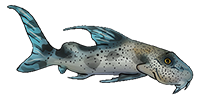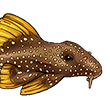| Scientific Name | Sperata seenghala (Sykes, 1839) |
| Common Name | Giant River-catfish |
| Type Locality | Deccan, India |
| Synonym(s) | Aor seenghala, Aor seenghala, Aoria seenghala, Aorichthys aor sarwari, Aorichthys seengala, Aorichthys seenghala, Bagrus aorinus, Bagrus lamarrii, Bagrus seenghala, Macrones lamarrii, Macrones seenghala, Mystus seenghala, Mystus seenghali, Mystus seenghara, Platystoma seenghala, Platystomus seenghala, Sperata sarwari |
| Pronunciation | ss per AT ah - SING hah lah |
| Etymology | The genus is named after MA Sperat. The specific epithet comes from the Bihari (and Oriya) names of the fish (seenghala or singara). |
| Size | 1500mm or 59.1" SL. Find near, nearer or same sized spp. |
| Identification | Eye situated completely in anterior half of head, more precaudal vertebrae (21-23) than congeners, length of supraoccipital spine less than interneural shield. |
| Sexing | Males are more slender and have an elongate genital papilla in front of the anal fin. |
| Distribution | Asia: Afghanistan, Pakistan, India, Nepal and Bangladesh. Indian waters, Andhra Pradesh State Waters, Krishna (click on these areas to find other species found there) Indian waters, North Eastern India Waters, Padma, Ganges (click on these areas to find other species found there) Pakistan Waters, Indus (click on these areas to find other species found there) Login to view the map. |
| IUCN Red List Category | Least Concern , range map and more is available on the IUCN species page. Last assessed 2009. |
| pH | 6.0 - 7.0 |
| Temperature | 20.0-25.0°C or 68-77°F (Show species within this range) |
| Feeding | Readily feeds on live or frozen foods, smaller fishes, shrimps, and prepared foods such as pellets. User data. |
| Furniture | Provide ample driftwood for shelter. |
| Compatibility | Not suitable with smaller tankmates, as it will eat them. Territorial with conspecifics, so best kept alone. |
| Breeding | Not reported in aquaria. Spawning is said to occur before the beginning of the southwest monsoon season in India. Individuals spawn at irregular intervals throughout the reproductive season and females can produce more than 1.2 million ova. It has been suggested that the males incubate the eggs in highly vascularized, spongy skin on the ventral surface of their abdomen and then feed the newly-hatched fry with a milky-white exudate from the abdominal wall. |
| Breeding Reports | There is no breeding report. |
| Reference | Proceedings of the Zoological Society of London 1838 (pt 6) (for 27 Nov. 1838), pp 164. |
| Registered Keepers | There is but a single registered keeper, view all "my cats" data. |
| Wishlists | Love this species? Click the heart to add it to your wish list. There is but a single wish to keep this species, see who wants what. |
| Spotters | Spotted this species somewhere? Click the binoculars! There are 3 records of this fish being seen, view them all. |
| Forum BBCode | |
| Search for S. seenghala | |
| Look up S. seenghala on AquaticRepublic.com | |
 | Look up S. seenghala on Fishbase |
 | Look up S. seenghala on Encyclopedia of Life |
 | Look up S. seenghala on Global Biodiversity Information Facility |
| LFS label creator ARN ref:1.8.76.1120 | |
| Last Update | 2025 Jan 02 01:39 (species record created: 2003 Sep 28 00:00) |





/siluriformes/bagridae/sperata/seenghala/1.jpg)
/siluriformes/bagridae/sperata/seenghala/2.jpg)
/siluriformes/bagridae/sperata/seenghala/3.jpg)
/siluriformes/bagridae/sperata/seenghala/4.jpg)
/siluriformes/bagridae/sperata/seenghala/5.jpg)
/siluriformes/bagridae/sperata/seenghala/6.jpg)
/siluriformes/bagridae/sperata/seenghala/7.jpg)
/siluriformes/bagridae/sperata/seenghala/8.jpg)
/siluriformes/bagridae/sperata/seenghala/9.jpg)